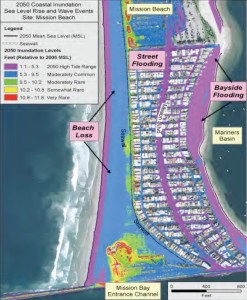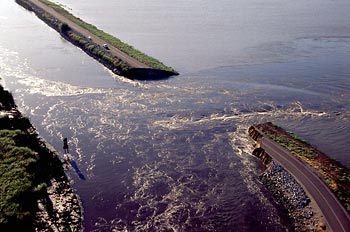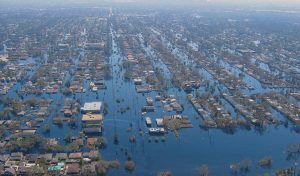As we burn more fossil fuels, and thus pump more heat-trapping greenhouse gases into the atmosphere, we are changing every aspect of earth’s climate system. One of the many consequences is that the sea is rising.
On January 19, San Diego 350 will stage a simple action to help make people more aware of what rising seas mean to San Diego right now, as well as in the future. We’re going to Mission Bay, which is pretty much ground-zero for sea-level rise in our county, to mark out where the high-water line is likely to be in about thirty years. Come join us. It’s pretty striking where that line will be.
This page will give you some of the background on why this action is important. We’ll fill you in on what is causing the sea to rise, how it is likely to rise over time, and why it matters to us in San Diego.
Why the sea is rising.The sea is rising now because [1,2,3] water expands as it warms, like the mercury in a thermometer. It is also rising because higher temperatures are melting glaciers worldwide. Even the great Greenland and West Antarctic ice sheets are beginning, gradually, but possibly inexorably, to melt and slide into the sea. The world’s average sea level has already risen about eight inches since the start of the Industrial Revolution [1,2,3]. How far and how fast it rises in the future depends on how much fossil fuel we continue to burn and how rapidly the great ice sheets respond to the warming climate. Though both of these factors are hard to predict [1,2,3], one recent estimate is that global average sea level is likely to rise 12 to 18 inches by 2050, and 36 to 55 inches by 2100 [4]. It could rise 30 or 40 feet over the next few centuries, if the Greenland [3,5] and West Antarctic [6] ice sheets collapse.
Here and now. Though 12 to 18 inches over a few decades might not seem like much, sea-level rise is something we need to deal with, right here in San Diego. The map below, from a report by the San Diego Foundation [7], shows what even a little sea-level rise can do to a low-lying area such as Mission Beach. By 2050, roughly half of Mission Beach will likely be flooded at high tide. Much of the rest would be flooded about once in five years, when higher sea levels, high tides and waves from big storms combine.

That flooding is going to cost San Diegans real money. Our quick check of real-estate listings suggests that property in Mission Beach costs about $20 Million to $40 Million per acre. At those prices, the property within the five-year flooded area on the map below is worth roughly $1 to 2 Billion. That estimate is very crude, of course, but it does indicate that sea-level rise can have real economic consequences.
2050 is only thirty-five years away. That’s about the length of a typical mortgage. It’s well within the time-scale on which we make plans for our lives, including our plans for financial security. If your financial planning includes property in Mission Beach, sea-level rise is something you need to think about, right now.
More than flooding. The rising sea will do more than flood property. It will exacerbate the loss of beaches that we are already suffering [8]. It will shrink what little is left of our coastal wetlands [9,10]. Those wetlands are nurseries for fish and shellfish, vital habitat for endangered birds and other wildlife, and natural filters for the polluted runoff from our streets [11,12].
Rising seas will also increase coastal erosion [13,14], which is already a problem in many San Diego communities such as Solana Beach [15], Carlsbad, Encinitas and others. California as a whole could lose 41 square miles of land to the sea by 2100 [16]. That’s equivalent to erasing a strip of land 200 feet wide along our entire 1100-mile coast. However, the actual erosion would be concentrated in certain areas, so the loss in those places would be even greater.
Too much of the wrong kind of water. One of San Diego’s biggest rising-sea problems is happening hundreds of miles away, in the San Francisco Bay Delta.
The Delta is a vast, low-lying maze of channels, fed by the San Joaquin and Sacramento Rivers and emptying into San Francisco Bay [17,18]. Much of Southern California’s water [17,18], including 20 to 30 % of San Diego’s [19], is pumped from a collection point in the Delta.

The problem is that the water level in the channels needs to stay a certain distance above sea level, to keep out the salt water that tries to push its way in from the Bay [18,20]. Yet, the reclaimed ground between the channels has sunk as much as 15 feet below sea level [17]. The water in the system is precariously kept above sea level by 1100 miles of aging levees. If those levees break at the wrong place, the water in the channels will drop, sea water will flood into the channels from the Bay, and the water supply for 25 million Californians [18] will be ruined for weeks or months [20]. As the sea rises, the water level in the Delta, and the pressure on those rotting levees, must increase. Sea-level rise is thus one of several factors that are making this vital water system unsustainable [18,20].
Our governor has advocated a possible fix that would cost $23 Billion [21]. That’s $600 for every person in the state. In this sense, the rising sea is costing us all real money, no matter how far above sea level we live. Our perilous water system is one very concrete example of how we are connected in surprising ways to places far away, and how much our well being depends on public policy that recognizes the reality of our changing environment.
Beyond San Diego. Of course, sea-level rise affects far more than our city and our state. The United States has more than $1 Trillion worth of infrastructure at risk of going under water, with just a two-foot rise in sea level [2]. Many American cities are at increasing risk of flooding at high tide [22]. That risk is especially high on the East and Gulf Coasts. There, sea-level rise is compounded because the land is sinking and the slowdown of the Gulf Stream – itself a consequence of global warming – is pushing the sea upward along the shore [23] .

In addition, in many America cities, a small rise in sea level can markedly increase the risks of flooding during severe storms. In San Francisco Bay, with sea levels just six inches higher, a relatively routine storm, such as might come along once a decade, could produce the same flooding that a much more severe, once-a-century storm would have produced before [24]. In Long Island Sound, a 19-inch rise in sea level would increase the property loss due to storm surge by 73% [25]. If the sea had been that high during Hurricane Sandy, coastal flooding losses would have been nearly $14 Billion. [26. See table, “The ten most significant flood events by National Flood Insurance payouts.”]
Along America’s Atlantic and Gulf coasts, more than 4 million homes worth more than $1 Trillion are at risk from hurricane storm-surge damage today. [26. See table, “Total potential residential exposure to hurricane storm-surge damage in coastal states.”] Higher sea levels will make this risk even greater. With so much investment at stake, rising seas are a very important factor in our nation’s economic security.
The future is now. The risks to Mission Bay, our Delta water system, and our nation’s infrastructure are examples of the very practical reasons why we need to mitigate climate change right now. But an even bigger reason is that our choices today will determine so much of the future, for such a long time to come.
Our responsibility to the future is spelled out by the physical processes that are causing the sea to rise. Those processes have several implications. First, the fossil fuels we burn today will affect the climate for hundreds or thousands of years, because the carbon dioxide we emit today will stay in the atmosphere that long [27,28,29]. Second, depending on how much carbon dioxide we allow to accumulate, the sea could rise by a tremendous amount over the next few hundred years: 23 feet if the Greenland ice sheet melted [5], another 15 feet if the West Antarctic ice sheet collapsed [6], even 70 feet if parts of the East Antarctic ice sheet collapsed as well [30]. Third, we are in deeper than we realize: As the heat slowly mixes down into the ocean and the ice sheets slide slowly downhill, the sea will continue to rise for centuries, just based on the greenhouse gases we have already emitted [3,5,6,31,32,33]. Yet, fourth, it is never too late to act: Although we have already caused a certain amount of sea-level rise that will unfold over time, we can always keep it from rising faster and farther by burning less fossil fuel [2,3,5,6,31,32,33].
Our action on January 19 is our effort to alert our fellow San Diegans to the reality of sea-level rise, its importance for us here and now, and the responsibility we have to every person who lives after us. We hope you will join us in Mission Beach, to see one small example of how real that responsibility is.
Thanks to George for his hard work researching sea-level rise, and to Bonnie for her thoughtful critique.
 This text is used here by permission of the author, and is licensed under a Creative Commons Attribution-NonCommercial-ShareAlike 3.0 Unported License.
This text is used here by permission of the author, and is licensed under a Creative Commons Attribution-NonCommercial-ShareAlike 3.0 Unported License.
